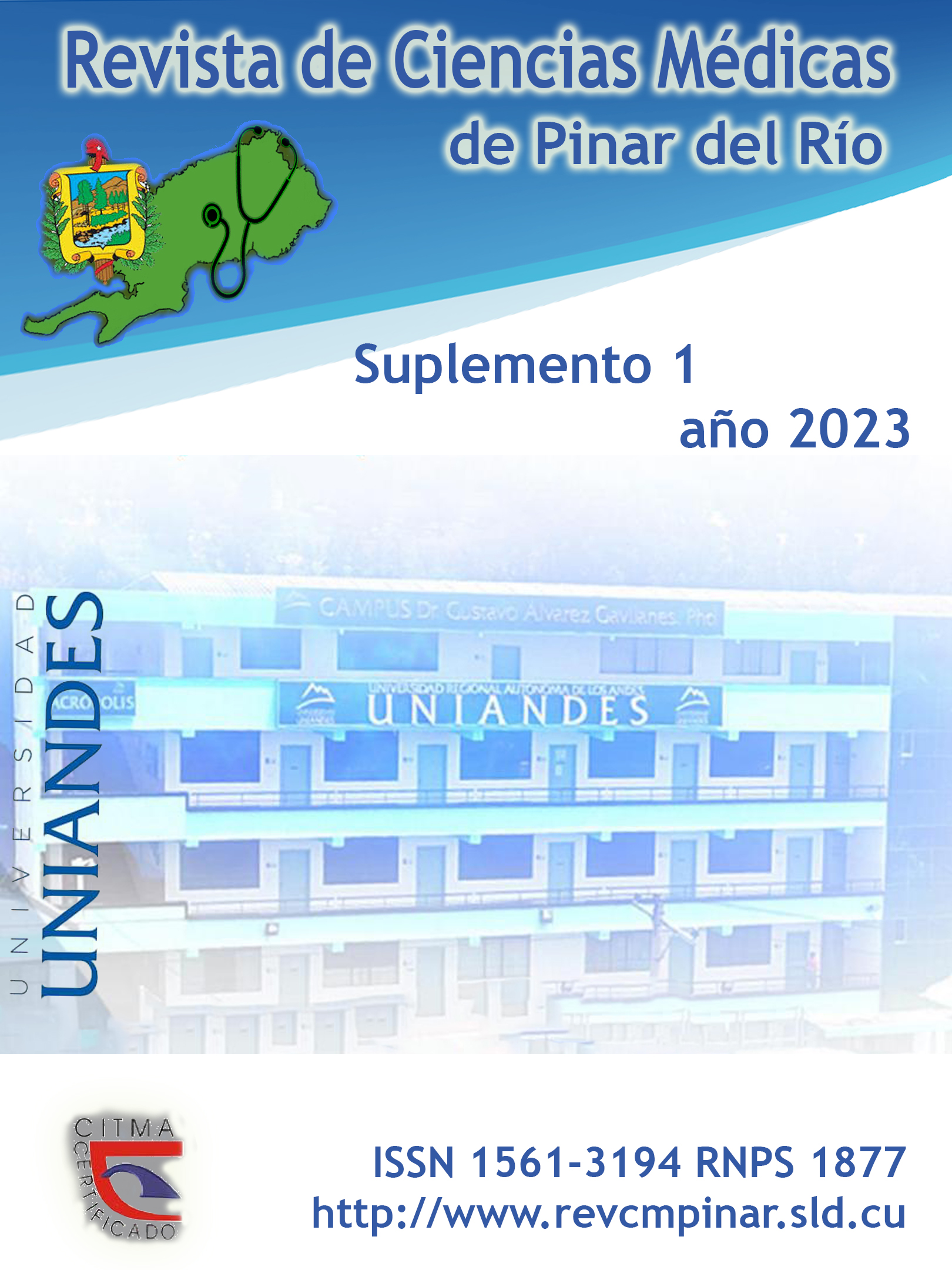Fluorosis dental en niños de 5-9 años de la comunidad Illahua Chico, parroquia Quisapincha, Tungurahua
Palabras clave:
PREVENCIÓN, FLUOROSIS, PATOLOGÍA, ANÁLISIS.Resumen
Introducción: la fluorosis dental es una alteración como resultado de la ingesta excesiva de flúor que se presenta durante la formación dentaria especialmente en los niños en edades comprendidas entre cinco a nueve años. El exceso de flúor provoca la desmineralización el esmalte dental, la misma puede presentarse en tres etapas: leve, moderada y grave.
Objetivo: caracterizar los niveles de fluorosis dental en niños de cinco a nueve años de edad de la comunidad Illagua Chico de la parroquia Quisapincha, Tungurahua, Ecuador; en el período comprendido entre octubre de 2021 a noviembre de 2022.
Métodos: se realizó un estudio observacional, descriptivo, de corte transversal con el propósito de caracterizar los niveles de fluorosis dental en niños de cinco a nueve años de edad en dicha comunidad en el período comprendido entre octubre de 2021 a noviembre de 2022. El estudio es la primera fase de un programa de salud oral aplicado en esta comunidad. La muestra se tomó de forma aleatoria simple y quedó conformada por 35 pacientes que cumplieron los criterios de inclusión y exclusión de un universo conformado por los 1080 habitantes de la comunidad.
Resultados: Se encontró que el 54,29 % de los pacientes fue del sexo femenino. Con respecto a la edad, predominaron los pacientes de siete y seis años (25,71 % y 22,86 % respectivamente). El análisis de fluorosis permitió identificar que el 40 % no presentó fluorosis y el 31 % la presentó de forma moderada.
Conclusiones: es imprescindible la implementación de un programa de salud oral que busque prevenir este problema con la aplicación de flúor en dosis establecidas y en tiempos determinados por los fabricantes y organismos gubernamentales nacionales e internacionales.
Descargas
Citas
1. Armas-Vega A del C, González-Martínez FD, Rivera-Martínez MS, Mayorga-Solórzano MF, Banderas-Benítez VE, Guevara-Cabrera OF. Factors associated with dental fluorosis in three zones of Ecuador. J Clin Exp Dent [Internet]. 2019 [citado 27/11/2022]; 11(1):e42-8. Disponible en: https://www.ncbi.nlm.nih.gov/pmc/articles/PMC6343983/
2. Shahroom N, Mani G, Ramakrishnan M. Interventions in management of dental fluorosis, an endemic disease: A systematic review. Journal Of Family Medicine And Primary Care [Internet]. 2019 [citado 27/11/2022]; 8(10): 3108. Disponible en: https://www.ncbi.nlm.nih.gov/pmc/articles/PMC6857403/
3. Michel-Crosato E, Raggio DP, Coloma-Valverde AN de J, Lopez EF, Alvarez-Velasco PL, Medina MV, et al. Oral health of 12-year-old children in Quito, Ecuador: a population-based epidemiological survey. BMC Oral Health [Internet]. 2019 [citado 27/11/2022]; 19(1):184. Disponible en: https://pubmed.ncbi.nlm.nih.gov/31412847/
4. Dean HT, Arnold FA, Elvolve E. Domestic water and dental caries. Additional studies of the relation of fluoride domestic waters to dental caries in 4425 white children, age 12-14 years of 13 cities in 4 states. Public Health Rep [Internet]. 1942 [citado 27/11/2022]; 57(32): 1155-1179. Disponible en: http://www.scielo.org.co/scielo.php?script=sci_nlinks&ref=4672418&pid=S0120-971X201600010000500001&lng=en
5. Fejerskov O, Baelum V, Manji F, Møller IJ. Dental fluorosis. A handbook for health care workers [Internet]. Copenhagen: Munksgaard; 1988 [citado 27/11/2022]. p.44-50. Disponible en: https://www.worldcat.org/es/title/dental-fluorosis-a-handbook-for-health-workers/oclc/466636905?referer=di&ht=edition
6. Di Giovanni T, Eliades T, Papageorgiou SN. Interventions for dental fluorosis: A systematic review. J Esthet Restor Dent [Internet]. 2018 [citado 27/11/2022]; 30(6): 502-8. Disponible en: https://pubmed.ncbi.nlm.nih.gov/30194793/
7. Ji M, Xiao L, Xu L, Huang S, Zhang D. How pH is regulated during amelogenesis in dental fluorosis. Exp Ther Med [Internet]. 2018 [citado 19/10/2022]; 16(5): 3759-65. Disponible en: https://www.ncbi.nlm.nih.gov/pmc/articles/PMC6201052/
8. Kanduti D, Sterbenk P, Artnik B. FLUORIDE: A REVIEW OF USE AND EFFECTS ON HEALTH. Mater Sociomed [Internet]. 2016 [citado 27/11/2022]; 28(2): 133-7. Disponible en: https://www.ncbi.nlm.nih.gov/pmc/articles/PMC4851520/
9. Do LG, Ha DH, Roberts-Thomson KF, Spencer AJ. Dental fluorosis in the Australian adult population. Aust Dent J [Internet]. 2020 [citado 27/11/2022]; 65 (Suppl. 1): S47-51. Disponible en: https://pubmed.ncbi.nlm.nih.gov/32583583/
10. Mendoza Curi YF. Informe final de las actividades realizadas en la sede “C.S Santa Rosa de Pachacutec” durante el periodo de octubre - febrero del 2017 [Internet]. 2017 [citado 27/11/2022]; Disponible en: https://repositorio.upch.edu.pe/handle/20.500.12866/728
11. Mesa Ruiz VE. Exposición inadvertida al ion flúor y su impacto sobre la fluorosis como problema de salud pública. Montería, 2019 [Internet]. Montevideo, Uruguay: Universidad de la República; 2021 [citado 27/11/2022]. Disponible en: https://repositorio.unicordoba.edu.co/handle/ucordoba/4026
12. Wei W, Shujuan P, and Dianjun S. The pathogenesis of endemic fluorosis: Research progress in the last 5 years. Journal of cellular and molecular medicine [Internet]. 2019 [citado 27/11/2022]; 23(4): 2333-2342. Disponible en: https://onlinelibrary.wiley.com/doi/full/10.1111/jcmm.14185
13. Akuno M H, Nocella G, Milia EP, Gutierrez L. Factors influencing the relationship between fluoride in drinking water and dental fluorosis: a ten-year systematic review and meta-analysis. J Water Health [Internet]. 2019 [citado 27/11/2022]; 17(6):845–862. Disponible en: https://doi.org/10.2166/wh.2019.300
14. Tabari ED, Ellwood R, Rugg-Gunn AJ, Evans DJ, Davies RM. Dental fluorosis in permanent incisor teeth in relation to water fluoridation, social deprivation and toothpaste use in infancy. Br Dent J [Internet]. 2000 [citado 27/11/2022]; 189(4): 216-20. Disponible en: https://pubmed.ncbi.nlm.nih.gov/11036750/
15. Neurath C, Limeback H. Dental Fluorosis Trends in US Oral Health Surveys: 1986 to 2012. JDR Clin Trans Res [Internet]. 2019 [citado 27/11/2022]; 4(4): 298–308. Disponible en: https://pubmed.ncbi.nlm.nih.gov/30931722/
Descargas
Publicado
Cómo citar
Número
Sección
Licencia
Aquellos autores/as que tengan publicaciones con esta revista, aceptan los términos siguientes:- Los autores/as conservarán sus derechos de autor y garantizarán a la revista el derecho de primera publicación de su obra, el cuál estará simultáneamente sujeto a la Licencia de reconocimiento de Creative Commons que permite a terceros compartir la obra siempre que se indique su autor y su primera publicación esta revista.
- Los autores/as podrán adoptar otros acuerdos de licencia no exclusiva de distribución de la versión de la obra publicada (p. ej.: depositarla en un archivo telemático institucional o publicarla en un volumen monográfico) siempre que se indique la publicación inicial en esta revista.
- Se permite y recomienda a los autores/as difundir su obra a través de Internet (p. ej.: en archivos telemáticos institucionales o en su página web) antes y durante el proceso de envío, lo cual puede producir intercambios interesantes y aumentar las citas de la obra publicada. (Véase El efecto del acceso abierto).



